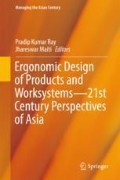Abstract
Hand screen printing, one among the prominent businesses in the textile sector of India lacks an ergonomic workplace and also stands behind in terms of research and development for improving the workers’ workability. Workability of a person also depends on his/her attitude toward a problem, thus a cognitive study was done among 385 workers with some key factors like stress, job satisfaction, willingness to work. Study was done to find association of the above said factors with their age, work experience, and their physique (especially weight). Descriptive analysis and repeated measures were done using SPSS v20. Results of descriptive analysis showed that, 75% of the population, who reported non-willingness fell under 1–5 years’ experience group. People with more than 10 years’ experience reported high stress (41.7%) and job satisfaction (33.3%) which was slightly less than 1–5 years’ experience group. Above results were backed up by the results of repeated measures test, as the mean of reported stress was found to be ‘high’ (CI 2.243–3.201) in the experience group of >10 years. Similar results were acquired for association with age. Major population who reported more stress and less satisfaction belonged to >40 years age group. But people who reported non-willingness to work were mostly of age 30–40 years. The mean of reported stress was almost similar for all the three (<30, 30–40, and >40 years) age groups, which gave an indication that the work environment needs an immediate alteration considering people’s stress relief. Simple modifications might be incorporated to the workplace, which might ease pressure out of workers’ head and eventually increase the workability.
Access this chapter
Tax calculation will be finalised at checkout
Purchases are for personal use only
References
Boyas J, Wind LH, Kang S-Y (2012) Exploring the relationship between employment-based social capital, job stress, burnout, and intent to leave among child protection workers: an age-based path analysis model. Child Youth Serv Rev 34:50–62
Fahey N, Soni A, Allison J, Vankar J, Prabhakaran A, Simas TM, Byatt N, Phatak A, O’Keefe E, Nimbalkar S (2016) Higher levels of education mitigate the relationship between perceived stress and common mental disorders among women in rural India: results of a cross-sectional study. Ann Glob Health 82:560
Fan L-B, Blumenthal J, Watkins L, Sherwood A (2015) Work and home stress: associations with anxiety and depression symptoms. Occup Med 65:110–116
Golubic R, Milosevic M, Knezevic B, Mustajbegovic J (2009) Work-related stress, education and work ability among hospital nurses. J Adv Nurs 65:2056–2066
Greenberg PE, Fournier A-A, Sisitsky T, Pike CT, Kessler RC (2015) The economic burden of adults with major depressive disorder in the United States (2005 and 2010). J Clin Psychiatry 76:155–162
Lindfors P, Meretoja O, Töyry S, Luukkonen R, Elovainio M, Leino T (2007) Job satisfaction, work ability and life satisfaction among Finnish anaesthesiologists. Acta Anaesthesiol Scand 51:815–822
Mauno S, Ruokolainen M, Kinnunen U (2013) Does aging make employees more resilient to job stress? age as a moderator in the job stressor–well-being relationship in three finnish occupational samples. Aging & Ment Health 17:411–422
Ohta M, Higuchi Y, Kumashiro M, Yamato H, Sugimura H (2015) Work improvement factors for the amelioration of work ability, with a focus on individual capacity to deal with stress in an IT company. J UOEH 37:23–32
Panchal S, Joshi HL, Kumar U (2015) Role of work environment in stress and mental health. J Res: THE BEDE ATHENAEUM 6:98–103
Sonnentag S, Fritz C (2015) Recovery from job stress: the stressor-detachment model as an integrative framework. J Organ Behav 36:S72–S103
Wakeham T, Harwood M, Carter J, Durocher J (2015) Obesity and neural cardiovascular responses to mental stress in humans. FASEB J 29: 806.805
Wang M-Y, Chiu C-H, Lee H-C, Su C-T, Tsai P-S (2016) Cardiovascular reactivity in patients with major depressive disorder with high-or low-level depressive symptoms a cross-sectional comparison of cardiovascular reactivity to laboratory-induced mental stress. Biol Res Nurs 18:221–229
Wiegner L, Hange D, Björkelund C, Ahlborg G (2015) Prevalence of perceived stress and associations to symptoms of exhaustion, depression and anxiety in a working age population seeking primary care-an observational study. BMC Fam Pract 16:1
Acknowledgements
The Authors would like to thank Science and Engineering Research Board (SERB), India, for their financial support and also the workers of hand screen printing industry for attending survey and experimental trails patiently.
Author information
Authors and Affiliations
Corresponding author
Editor information
Editors and Affiliations
Rights and permissions
Copyright information
© 2018 Springer Nature Singapore Pte Ltd.
About this chapter
Cite this chapter
Shankar, S., Karthick, J., Naveenkumar, R. (2018). Ergonomics for Hand Screen Printing Workers: Cognitive Perception. In: Ray, P., Maiti, J. (eds) Ergonomic Design of Products and Worksystems - 21st Century Perspectives of Asia. Managing the Asian Century. Springer, Singapore. https://doi.org/10.1007/978-981-10-5457-0_13
Download citation
DOI: https://doi.org/10.1007/978-981-10-5457-0_13
Published:
Publisher Name: Springer, Singapore
Print ISBN: 978-981-10-5456-3
Online ISBN: 978-981-10-5457-0
eBook Packages: Business and ManagementBusiness and Management (R0)

